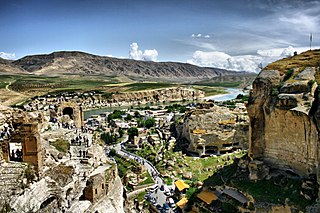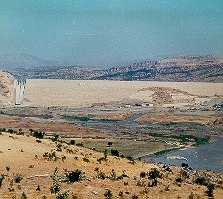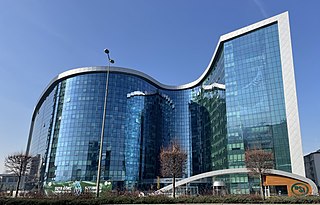
Batman Province is a province in Turkey. It was created in May 1990 with the Law No. 3647 taking some parts from the eastern Province of Siirt and some from the southern Province of Mardin. The province had a population of 634,491 in 2022 and its current governor is Ekrem Canalp.
The Atatürk Dam, originally the Karababa Dam, is the third largest dam in the world and it is a zoned rock-fill dam with a central core on the Euphrates River on the border of Adıyaman Province and Şanlıurfa Province in the Southeastern Anatolia Region of Turkey. Built both to generate electricity and to irrigate the plains in the region, it was renamed in honour of Mustafa Kemal Atatürk (1881–1938), the founder of the Turkish Republic. The construction began in 1983 and was completed in 1990. The dam and the hydroelectric power plant, which went into service after the upfilling of the reservoir was completed in 1992, are operated by the State Hydraulic Works (DSİ). The reservoir created behind the dam, called Atatürk Reservoir, is the third largest in Turkey.
The Southeastern Anatolia Project is a multi-sector integrated regional development project based on the concept of sustainable development for the 9 million people (2005) living in the Southeastern Anatolia region of Turkey. According to a governmental source, the aim of the GAP is to eliminate regional development disparities by raising incomes and living standards and to contribute to the national development targets of social stability and economic growth by enhancing the productive and employment generating capacity of the rural sector. The total cost of the project is over 100 billion Turkish lira (TL), of which 30.6 billion TL of this investment was realized at the end of 2010. The real investment was 72.6% for the end of 2010. The project area covers nine provinces which are located in the basins of the Euphrates and Tigris and in Upper Mesopotamia.

The Birecik Dam, one of the 21 dams of the Southeastern Anatolia Project of Turkey, is located on the Euphrates River 60 km (37 mi) downstream of Atatürk Dam and 8 km (5.0 mi) upstream of Birecik town 80 km (50 mi) west of Province of Şanlıurfa in the southeastern region of Turkey. It was purposed for irrigation and energy production. There is a run-of-the-river hydroelectric power plant, established in 2001, at the dam, with a power output of 672MW can generate an average of 2.5 billion kWh per year. The Birecik dam is a structure consisting of a concrete gravity and clay core sandgravel fill with a height of 62.5 m (205 ft) from the foundation. It was designed by Coyne et Bellier. The total catchment area is 92,700 ha (358 sq mi). The Birecik project will be realized under the status of Build-Operate-Transfer (BOT) model.

Devegeçidi Dam is one of the 22 dams of the Southeastern Anatolia Project of Turkey, Diyarbakır. It is near Diyarbakır on a branch of the Tigris river. It was constructed for irrigation purposes between 1965 and 1972.

Dicle Dam is one of the 21 dams of the Southeastern Anatolia Project of Turkey. These facilities are located within the provincial territory of Diyarbakır, at a distance of 50 kilometres to Diyarbakır city centre. More specifically, the dam and the hydroelectric power plant are located in Eğil district, at a distance of 800 metres from the point of junction of the streams of Maden Stream and Dibni to form the Tigris, and 22 kilometres downstream of the Kralkızı Dam. Construction works were started in 1986 and the dam was completed in 1997. The dam has an installed hydroelectric capacity of 110 MW and is designed to ultimately irrigate 128,080 hectares. In 2001 a water transmission line and a water treatment plant were commissioned that provided about 85% of the drinking water for the city of Diyarbakir in 2010. In 2018 a gate of the dam broke the water lever decreased and a part of a village re-emerged in the Eğil district.

The Karakaya Dam is one of the 21 dams of the Southeastern Anatolia Project of Turkey, built on the Euphrates River and completed in 1987. The hydroelectric dam generates power with six units of 300 MW, totalling the installed capacity to 1,800 MW.

Karkamış Dam is one of the 21 dams of the Southeastern Anatolia Project of Turkey. It is on the Euphrates River. The foundation of the dam was laid in 1996, and is 4.5 kilometres (2.8 mi) from the Syria border. The hydroelectric power plant has a total installed power capacity of 189 megawatts (253,000 hp).

Kralkızı Dam is one of the 21 dams of the Southeastern Anatolia Project of Turkey in Batman. The hydroelectric power plant has a total installed power capacity of 94 MW. The dam was constructed between 1985 and 1997.

The Ilısu Dam is a concrete-face rock-fill dam on the Tigris near the village of Ilısu and along the border of Mardin and Şırnak Provinces in Turkey. It is one of the 22 dams of the Southeastern Anatolia Project and its purpose is hydroelectric power production, flood control and water storage. When operational, the dam will support a 1,200 MW power station and will form a 10.4 billion m3 reservoir. Construction of the dam began in 2006 and was originally expected to be completed by 2016. As part of the project, the much smaller Cizre Dam is to be constructed downstream for irrigation and power. The dam has drawn international controversy, because it will flood portions of ancient Hasankeyf and necessitate the relocation of people living in the region. Because of this, the dam lost international funding in 2008. Most historical structures in Hasankeyf were moved to the new Hasankeyf prior to the filling of the dam. The dam began to fill its reservoir in late July 2019. Due to rainfall, the dam has achieved water levels up to 100m above the river bed and stored 5 billion cubic meters of water. The water level had reached an elevation of 498.2m on 1 April 2020.

Kılıçkaya Dam is a dam located 25 km north of town of Suşehri 158 km northeast of Sivas city in center east of Turkey and located on the Kelkit, a tributary of the Yeşilırmak River which flows down along a large fault in the north east Anatolia than runs into the Black Sea.

Silvan Dam is an embankment concrete-face rock-fill currently under construction on the Batman River in the district of Silvan, Diyarbakır Province in southeastern Turkey. It is part of the Southeastern Anatolia Project and located upstream of the Batman Dam. Construction began on 26 July 2011 and is expected to be complete in 2022. The purpose of the dam is hydroelectric power production and irrigation. It is designed to irrigate an area of 245,000 ha. The power station will have an installed capacity of 160 MW.

The State Hydraulic Works is a state agency, under the Ministry of Environment and Forestry of Turkey, responsible for the utilization of all the country's water resources. The institution's four major functions are energy, agriculture, services and environment. The General Manager of DSI is Kaya Yıldız.
The Cizre Dam is a proposed dam on the Tigris River north of Cizre, Turkey. The Cizre Dam is to be built in conjunction and downstream of the Ilisu Dam. The Cizre Dam is also one of the planned dams of Turkey's Southeastern Anatolia Project (GAP). The purpose of the Cizre Dam is irrigation, hydro-power and to control the tailwaters of the Ilisu Dam.
Derbent Dam is a gravity/embankment dam on the Kızılırmak River in Samsun Province, Turkey. The development was backed by the Turkish State Hydraulic Works.
The Kayacık Dam impounds the Ayfinar Deresi, one of the two streams that join south of Gaziantep to form the Sajur River. It is located in Gaziantep Province, Turkey. The dam was constructed between 1993 and 2005 as part of the Southeastern Anatolia Project. It is 45 metres (148 ft) high and has a volume of 1,853,000 cubic metres (65,400,000 cu ft). The reservoir created by the Kayacık Dam has a surface area of 11 square kilometres (4.2 sq mi) and a volume of 0.117 cubic kilometres (0.028 cu mi) and is used to irrigate an area of 200 square kilometres (77 sq mi).

The Arkun Dam an embankment dam on the Çoruh River near İspir in Erzurum Province, Turkey. Construction began in 2011 and the primary purpose of the dam is hydroelectric power generation. It is part of the Çoruh Development Plan and its construction is being supervised by Turkey's State Hydraulic Works. The dam and power plant were completed early, in June 2014. Water from the dam's reservoir supplies two power stations; one at the dam's toe (base) and the other downstream in Artvin Province.
The Laleli Dam is an embankment dam, currently under construction near the town of Laleli on the Çoruh River in Erzurum Province, Turkey. The primary purpose of the dam is hydroelectric power production. The dam, which will power a 99 MW power station, will also flood several villages to include Laleli. The dam's reservoir will stretch east into Bayburt Province.
Garzan Dam is an embankment dam on the Garzan River 9 km (5.6 mi) northeast of Kozluk in Batman Province, Turkey. It is part of the Southeastern Anatolia Project and has a primary purpose of hydroelectric power generation and irrigation. Surveys for the dam were completed in 2008, construction began in 2009 and the dam began to impound its reservoir in October 2012. The power plant has an installed capacity of 49 MW. The irrigation works remain under construction and are expected to irrigate an area of 40,000 ha when complete. The dam was awarded to FERNAS Energy Electricity Generation Co. Inc. in 2011 under a build–operate–transfer basis.

Hydroelectricity is a major source of electricity in Turkey, due to its mountainous landscape and many rivers. The country's main river basins are the Euphrates and Tigris. Over 700 hydropower plants have been built, and they make up about 30% of the country's electricity generating capacity. Annual generation varies greatly, and in rainy years lots of hydroelectric power can be generated. Government policies have generally supported building dams, but some are controversial in neighbouring countries, and some raise concerns about damage to the environment and wildlife.
















